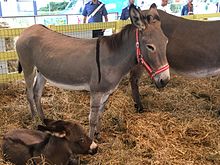 | |
| Conservation status | FAO: endangered |
|---|---|
| Other names | Asino dell'Amiata |
| Country of origin | Italy |
| Distribution | mainly in Tuscany |
| Use |
|
| Traits | |
| Weight |
|
| Height |
|
| Classification | |
| MIPAAF | Breed standard |
| |

The Amiatina or Italian: Asino dell'Amiata is a breed of donkey from Tuscany in central Italy. It is particularly associated with Monte Amiata in the provinces of Siena and Grosseto, but is distributed throughout Tuscany. There are also populations in Liguria and in Campania. It is one of the eight autochthonous donkey breeds of limited distribution recognised by the Ministero delle Politiche Agricole Alimentari e Forestali, the Italian ministry of agriculture and forestry.
History
The Amiatina was numerous in the early part of the twentieth century; before the Second World War the population in the provinces of Grosseto and Perugia alone was over 8000. In the years following the War it came close to extinction. From 1956 the Deposito Stalloni (later the Istituto di Incremento Ippico) of Pisa selectively bred it in the province of Grosseto. A breeders' association was founded in 1993. In 1995 the registered population was 89. In 2006 the total number registered was 1082, of which about 60% were in Tuscany. The Amiatina was listed as "endangered" by the FAO in 2007.
Characteristics
The Amiatina is intermediate in size between large breeds such as the Martina Franca and the Ragusano and small ones such as the Sarda. It rarely exceeds 140 cm at the withers. The coat is mouse-grey, with well-defined primitive markings – dorsal and shoulder stripes forming a cross, and zebra stripes on the legs. It is a strong and rustic breed, capable of foraging on harsh marginal terrain. Management is almost always free range.
References
- ^ Barbara Rischkowsky, D. Pilling (eds.) (2007). List of breeds documented in the Global Databank for Animal Genetic Resources, annex to The State of the World's Animal Genetic Resources for Food and Agriculture. Rome: Food and Agriculture Organization of the United Nations. ISBN 9789251057629. Accessed May 2014.
- ^ Breed data sheet: Asino dell'Amiata / Italy. Domestic Animal Diversity Information System of the Food and Agriculture Organization of the United Nations. Accessed September 2013.
- ^ Daniele Bigi, Alessio Zanon (2008). Atlante delle razze autoctone: Bovini, equini, ovicaprini, suini allevati in Italia (in Italian). Milan: Edagricole. ISBN 9788850652594.
- Norme tecniche: Allegato 2 a D.M. 9742 del 7 maggio 2012 (in Italian). Ministero delle Politiche Agricole Alimentari e Forestali. p. 18. Accessed September 2013.
- ^ Riccardo Fortina (2000). Le razze di animali domestici in pericolo di estinzione: Asino dell'Amiata. (in Italian). Vita in campagna 2000 (12): 46.
External links
- [REDACTED] Media related to Asino dell'Amiata at Wikimedia Commons
| Donkey breeds of Italy | |||||
|---|---|---|---|---|---|
| These are the donkey breeds considered in Italy to be wholly or partly of Italian origin. Many have complex or obscure histories, so inclusion here does not necessarily imply that a breed is predominantly or exclusively Italian. | |||||
|
This article about an odd-toed ungulate is a stub. You can help Misplaced Pages by expanding it. |